LPC824 Microcontroller: Datasheet, Pinout, NXP LPC824
32KB 32K x 8 FLASH ARM® Cortex®-M0+ 32-Bit Microcontroller LPC82x Series LPC824M201 3.3V 32-VFQFN Exposed Pad









32KB 32K x 8 FLASH ARM® Cortex®-M0+ 32-Bit Microcontroller LPC82x Series LPC824M201 3.3V 32-VFQFN Exposed Pad
This article will unlock more detailed information about LPC824, a 32-bit ARM® Cortex®-M0+ microcontroller. There is a huge range of Semiconductors, Capacitors, Resistors and ICs in stock. Welcome RFQ.

Testing NXP MCUs touch solutions
LPC824 Pinout

LPC824 Pinout
LPC824 CAD Model
Symbol
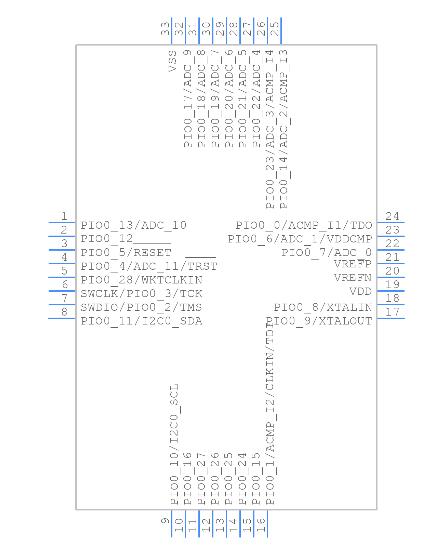
LPC824 Symbol
Footprint
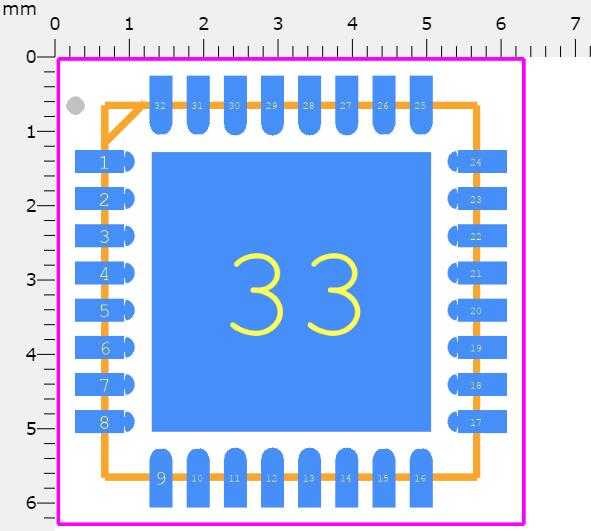
LPC824 Footprint
3D Model
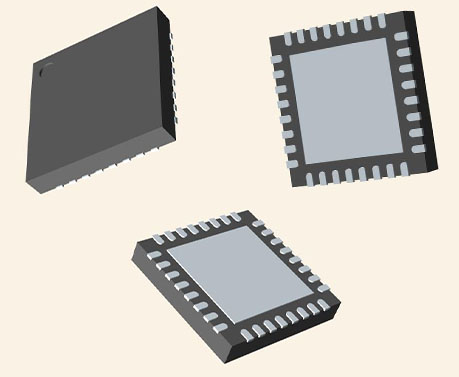
LPC824 3D Model
LPC824 Description
The LPC824 is from LPC82x, an ARM Cortex-M0+ based, low-cost 32-bit MCU family operating at CPU frequencies of up to 30 MHz. The LPC82x support up to 32 KB of flash memory and 8 KB of SRAM. The peripheral complement of the LPC82x includes a CRC engine, four I2C-bus interfaces, up to three USARTs, up to two SPI interfaces, one multi-rate timer, self-wake-up timer, and a state-configurable timer with PWM function (SCTimer/PWM), a DMA, one 12-bit ADC and one analogue comparator, function-configurable I/O ports through a switch matrix, an input pattern match engine, and up to 29 general-purpose I/O pins.
Specifications
- TypeParameter
- Factory Lead Time12 Weeks
- Mounting Type
The "Mounting Type" in electronic components refers to the method used to attach or connect a component to a circuit board or other substrate, such as through-hole, surface-mount, or panel mount.
Surface Mount - Package / Case
refers to the protective housing that encases an electronic component, providing mechanical support, electrical connections, and thermal management.
32-VFQFN Exposed Pad - Surface Mount
having leads that are designed to be soldered on the side of a circuit board that the body of the component is mounted on.
YES - Data ConvertersA/D 12x12b
- Number of I/Os29
- ROM(word)32768
- Operating Temperature
The operating temperature is the range of ambient temperature within which a power supply, or any other electrical equipment, operate in. This ranges from a minimum operating temperature, to a peak or maximum operating temperature, outside which, the power supply may fail.
-40°C~105°C TA - Packaging
Semiconductor package is a carrier / shell used to contain and cover one or more semiconductor components or integrated circuits. The material of the shell can be metal, plastic, glass or ceramic.
Tray - Series
In electronic components, the "Series" refers to a group of products that share similar characteristics, designs, or functionalities, often produced by the same manufacturer. These components within a series typically have common specifications but may vary in terms of voltage, power, or packaging to meet different application needs. The series name helps identify and differentiate between various product lines within a manufacturer's catalog.
LPC82x - Published2005
- Part Status
Parts can have many statuses as they progress through the configuration, analysis, review, and approval stages.
Discontinued - Moisture Sensitivity Level (MSL)
Moisture Sensitivity Level (MSL) is a standardized rating that indicates the susceptibility of electronic components, particularly semiconductors, to moisture-induced damage during storage and the soldering process, defining the allowable exposure time to ambient conditions before they require special handling or baking to prevent failures
3 (168 Hours) - Number of Terminations33
- Additional Feature
Any Feature, including a modified Existing Feature, that is not an Existing Feature.
SEATED HGT-NOM - Terminal Position
In electronic components, the term "Terminal Position" refers to the physical location of the connection points on the component where external electrical connections can be made. These connection points, known as terminals, are typically used to attach wires, leads, or other components to the main body of the electronic component. The terminal position is important for ensuring proper connectivity and functionality of the component within a circuit. It is often specified in technical datasheets or component specifications to help designers and engineers understand how to properly integrate the component into their circuit designs.
QUAD - Terminal Form
Occurring at or forming the end of a series, succession, or the like; closing; concluding.
NO LEAD - Peak Reflow Temperature (Cel)
Peak Reflow Temperature (Cel) is a parameter that specifies the maximum temperature at which an electronic component can be exposed during the reflow soldering process. Reflow soldering is a common method used to attach electronic components to a circuit board. The Peak Reflow Temperature is crucial because it ensures that the component is not damaged or degraded during the soldering process. Exceeding the specified Peak Reflow Temperature can lead to issues such as component failure, reduced performance, or even permanent damage to the component. It is important for manufacturers and assemblers to adhere to the recommended Peak Reflow Temperature to ensure the reliability and functionality of the electronic components.
260 - Supply Voltage
Supply voltage refers to the electrical potential difference provided to an electronic component or circuit. It is crucial for the proper operation of devices, as it powers their functions and determines performance characteristics. The supply voltage must be within specified limits to ensure reliability and prevent damage to components. Different electronic devices have specific supply voltage requirements, which can vary widely depending on their design and intended application.
3.3V - Terminal Pitch
The center distance from one pole to the next.
0.5mm - Time@Peak Reflow Temperature-Max (s)
Time@Peak Reflow Temperature-Max (s) refers to the maximum duration that an electronic component can be exposed to the peak reflow temperature during the soldering process, which is crucial for ensuring reliable solder joint formation without damaging the component.
NOT SPECIFIED - Base Part Number
The "Base Part Number" (BPN) in electronic components serves a similar purpose to the "Base Product Number." It refers to the primary identifier for a component that captures the essential characteristics shared by a group of similar components. The BPN provides a fundamental way to reference a family or series of components without specifying all the variations and specific details.
LPC824M201 - Pin Count
a count of all of the component leads (or pins)
32 - JESD-30 Code
JESD-30 Code refers to a standardized descriptive designation system established by JEDEC for semiconductor-device packages. This system provides a systematic method for generating designators that convey essential information about the package's physical characteristics, such as size and shape, which aids in component identification and selection. By using JESD-30 codes, manufacturers and engineers can ensure consistency and clarity in the specification of semiconductor packages across various applications and industries.
S-PQCC-N33 - Supply Voltage-Max (Vsup)
The parameter "Supply Voltage-Max (Vsup)" in electronic components refers to the maximum voltage that can be safely applied to the component without causing damage. It is an important specification to consider when designing or using electronic circuits to ensure the component operates within its safe operating limits. Exceeding the maximum supply voltage can lead to overheating, component failure, or even permanent damage. It is crucial to adhere to the specified maximum supply voltage to ensure the reliable and safe operation of the electronic component.
3.6V - Supply Voltage-Min (Vsup)
The parameter "Supply Voltage-Min (Vsup)" in electronic components refers to the minimum voltage level required for the component to operate within its specified performance range. This parameter indicates the lowest voltage that can be safely applied to the component without risking damage or malfunction. It is crucial to ensure that the supply voltage provided to the component meets or exceeds this minimum value to ensure proper functionality and reliability. Failure to adhere to the specified minimum supply voltage may result in erratic behavior, reduced performance, or even permanent damage to the component.
1.8V - Oscillator Type
Wien Bridge Oscillator; RC Phase Shift Oscillator; Hartley Oscillator; Voltage Controlled Oscillator; Colpitts Oscillator; Clapp Oscillators; Crystal Oscillators; Armstrong Oscillator.
Internal - Speed
In electronic components, "Speed" typically refers to the rate at which data can be processed or transferred within the component. It is a measure of how quickly the component can perform its functions, such as executing instructions or transmitting signals. Speed is often specified in terms of frequency, such as clock speed in processors or data transfer rate in memory modules. Higher speed components can perform tasks more quickly, leading to improved overall performance in electronic devices. It is an important parameter to consider when designing or selecting electronic components for specific applications.
30MHz - RAM Size
RAM size refers to the amount of random access memory (RAM) available in an electronic component, such as a computer or smartphone. RAM is a type of volatile memory that stores data and instructions that are actively being used by the device's processor. The RAM size is typically measured in gigabytes (GB) and determines how much data the device can store and access quickly for processing. A larger RAM size allows for smoother multitasking, faster loading times, and better overall performance of the electronic component. It is an important factor to consider when choosing a device, especially for tasks that require a lot of memory, such as gaming, video editing, or running multiple applications simultaneously.
8K x 8 - Voltage - Supply (Vcc/Vdd)
Voltage - Supply (Vcc/Vdd) is a key parameter in electronic components that specifies the voltage level required for the proper operation of the device. It represents the power supply voltage that needs to be provided to the component for it to function correctly. This parameter is crucial as supplying the component with the correct voltage ensures that it operates within its specified limits and performance characteristics. It is typically expressed in volts (V) and is an essential consideration when designing and using electronic circuits to prevent damage and ensure reliable operation.
1.8V~3.6V - uPs/uCs/Peripheral ICs Type
The parameter "uPs/uCs/Peripheral ICs Type" refers to the classification of various integrated circuits used in electronic devices. It encompasses microprocessors (uPs), microcontrollers (uCs), and peripheral integrated circuits that provide additional functionalities. This classification helps in identifying the specific type of chip used for processing tasks, controlling hardware, or interfacing with other components in a system. Understanding this parameter is essential for selecting the appropriate electronic components for a given application.
MICROCONTROLLER, RISC - Core Processor
The term "Core Processor" typically refers to the central processing unit (CPU) of a computer or electronic device. It is the primary component responsible for executing instructions, performing calculations, and managing data within the system. The core processor is often considered the brain of the device, as it controls the overall operation and functionality. It is crucial for determining the speed and performance capabilities of the device, as well as its ability to handle various tasks and applications efficiently. In modern devices, core processors can have multiple cores, allowing for parallel processing and improved multitasking capabilities.
ARM® Cortex®-M0+ - Peripherals
In the context of electronic components, "Peripherals" refer to devices or components that are connected to a main system or device to enhance its functionality or provide additional features. These peripherals can include input devices such as keyboards, mice, and touchscreens, as well as output devices like monitors, printers, and speakers. Other examples of peripherals include external storage devices, network adapters, and cameras. Essentially, peripherals are external devices that expand the capabilities of a main electronic system or device.
Brown-out Detect/Reset, DMA, POR, PWM, WDT - Clock Frequency
Clock frequency, also known as clock speed, refers to the rate at which a processor or electronic component can execute instructions. It is measured in hertz (Hz) and represents the number of cycles per second that the component can perform. A higher clock frequency typically indicates a faster processing speed and better performance. However, it is important to note that other factors such as architecture, efficiency, and workload also play a significant role in determining the overall performance of a component. In summary, clock frequency is a crucial parameter that influences the speed and efficiency of electronic components in processing data and executing tasks.
25MHz - Program Memory Type
Program memory typically refers to flash memory when it is used to hold the program (instructions). Program memory may also refer to a hard drive or solid state drive (SSD). Contrast with data memory.
FLASH - Core Size
Core size in electronic components refers to the physical dimensions of the core material used in devices such as inductors and transformers. The core size directly impacts the performance characteristics of the component, including its inductance, saturation current, and frequency response. A larger core size typically allows for higher power handling capabilities and lower core losses, while a smaller core size may result in a more compact design but with limitations on power handling and efficiency. Designers must carefully select the core size based on the specific requirements of the application to achieve optimal performance and efficiency.
32-Bit - Program Memory Size
Program Memory Size refers to the amount of memory available in an electronic component, such as a microcontroller or microprocessor, that is used to store program instructions. This memory is non-volatile, meaning that the data stored in it is retained even when the power is turned off. The program memory size determines the maximum amount of code that can be stored and executed by the electronic component. It is an important parameter to consider when selecting a component for a specific application, as insufficient program memory size may limit the functionality or performance of the device.
32KB 32K x 8 - Connectivity
In electronic components, "Connectivity" refers to the ability of a component to establish and maintain connections with other components or devices within a circuit. It is a crucial parameter that determines how easily signals can be transmitted between different parts of a circuit. Connectivity can be influenced by factors such as the number of input and output ports, the type of connectors used, and the overall design of the component. Components with good connectivity are essential for ensuring reliable and efficient operation of electronic systems.
I2C, SPI, UART/USART - Bit Size
In electronic components, "Bit Size" refers to the number of bits that can be processed or stored by a particular component. A bit is the smallest unit of data in computing and can have a value of either 0 or 1. The Bit Size parameter is commonly used to describe the capacity or performance of components such as microprocessors, memory modules, and data buses. A larger Bit Size generally indicates a higher processing capability or storage capacity, allowing for more complex operations and larger amounts of data to be handled efficiently. It is an important specification to consider when selecting electronic components for specific applications that require certain levels of performance and data processing capabilities.
32 - Has ADC
Has ADC refers to the presence of an Analog-to-Digital Converter (ADC) in an electronic component. An ADC is a crucial component in many electronic devices as it converts analog signals, such as voltage or current, into digital data that can be processed by a digital system. Having an ADC allows the electronic component to interface with analog signals and convert them into a format that can be manipulated and analyzed digitally. This parameter is important for applications where analog signals need to be converted into digital form for further processing or control.
YES - DMA Channels
DMA (Direct Memory Access) Channels are a feature found in electronic components such as microcontrollers, microprocessors, and peripheral devices. DMA Channels allow data to be transferred directly between peripherals and memory without involving the CPU, thereby reducing the burden on the CPU and improving overall system performance. Each DMA Channel is typically assigned to a specific peripheral device or memory region, enabling efficient data transfer operations. The number of DMA Channels available in a system determines the concurrent data transfer capabilities and can vary depending on the specific hardware design. Overall, DMA Channels play a crucial role in optimizing data transfer efficiency and system performance in electronic devices.
YES - PWM Channels
PWM Channels, or Pulse Width Modulation Channels, refer to the number of independent PWM outputs available in an electronic component, such as a microcontroller or a motor driver. PWM is a technique used to generate analog-like signals by varying the duty cycle of a square wave signal. Each PWM channel can control the output of a specific device or component by adjusting the pulse width of the signal. Having multiple PWM channels allows for precise control of multiple devices simultaneously, making it a valuable feature in applications such as motor control, LED dimming, and audio signal generation. The number of PWM channels available in a component determines the flexibility and complexity of the system it can control.
YES - DAC Channels
DAC Channels refer to the number of independent analog output channels available in a digital-to-analog converter (DAC) electronic component. Each channel can convert a digital input signal into an analog output voltage or current. The number of DAC channels determines how many separate analog signals can be generated simultaneously by the DAC. For example, a DAC with two channels can output two different analog signals at the same time, while a DAC with only one channel can only output a single analog signal. The number of DAC channels is an important specification to consider when selecting a DAC for applications requiring multiple analog outputs.
NO - On Chip Program ROM Width
The parameter "On Chip Program ROM Width" refers to the data width of the read-only memory (ROM) implemented on a semiconductor chip. It indicates the number of bits that can be accessed simultaneously in each ROM read operation. A wider ROM width allows for faster data retrieval and processing, as more information can be transferred at once. This parameter is crucial in determining the overall performance and efficiency of electronic devices that utilize programmable ROM for storing firmware or application logic.
8 - Length5mm
- Height Seated (Max)
Height Seated (Max) is a parameter in electronic components that refers to the maximum allowable height of the component when it is properly seated or installed on a circuit board or within an enclosure. This specification is crucial for ensuring proper fit and alignment within the overall system design. Exceeding the maximum seated height can lead to mechanical interference, electrical shorts, or other issues that may impact the performance and reliability of the electronic device. Manufacturers provide this information to help designers and engineers select components that will fit within the designated space and function correctly in the intended application.
0.85mm - Width5mm
- RoHS Status
RoHS means “Restriction of Certain Hazardous Substances” in the “Hazardous Substances Directive” in electrical and electronic equipment.
ROHS3 Compliant
Parts with Similar Specs
- ImagePart NumberManufacturerPackage / CaseSupply VoltageMoisture Sensitivity Level (MSL)Program Memory TypeMounting TypeVoltage - Supply (Vcc/Vdd)Core SizePackagingView Compare
LPC824M201JHI33E
32-VFQFN Exposed Pad
3.3 V
3 (168 Hours)
FLASH
Surface Mount
1.8V ~ 3.6V
32-Bit
Tray
32-VFQFN Exposed Pad
-
3 (168 Hours)
FLASH
Surface Mount
1.8V ~ 3.6V
32-Bit
Tray
32-VQFN Exposed Pad
3.3 V
3 (168 Hours)
FLASH
Surface Mount
1.8V ~ 3.6V
32-Bit
Tray
32-VQFN Exposed Pad
3.3 V
3 (168 Hours)
FLASH
Surface Mount
1.8V ~ 3.6V
32-Bit
Tray
LPC824 Features
lSystem:
ARM Cortex-M0+ processor (revision r0p1), running at frequencies of up to 30 MHz with single-cycle multiplier and fast single-cycle I/O port.
ARM Cortex-M0+ built-in Nested Vectored Interrupt Controller (NVIC).
System tick timer.
AHB multilayer matrix.
Serial Wire Debug (SWD) with four breakpoints and two watchpoints. JTAG boundary-scan (BSDL) supported.
MTB
lMemory:
Up to 32 KB on-chip flash programming memory with 64 Byte page write and erase. Code Read Protection (CRP) supported.
8 KB SRAM.
lROM API support:
Boot loader.
On-chip ROM APIs for ADC, SPI, I2C, USART, power configuration (power profiles) and integer divide.
Flash In-Application Programming (IAP) and In-System Programming (ISP).
lDigital peripherals:
High-speed GPIO interface connected to the ARM Cortex-M0+ IO bus with up to 29 General-Purpose I/O (GPIO) pins with configurable pull-up/pull-down resistors, programmable open-drain mode, input inverter, and digital filter. GPIO direction control supports independent set/clear/toggle of individual bits.
High-current source output driver (20 mA) on four pins.
High-current sink driver (20 mA) on two true open-drain pins.
GPIO interrupt generation capability with boolean pattern-matching feature on eight GPIO inputs.
Switch matrix for flexible configuration of each I/O pin function.
CRC engine.
DMA with 18 channels and 9 trigger inputs.
lTimers:
State Configurable Timer (SCTimer/PWM) with input and output functions (including capture and match) for timing and PWM applications. Each SCTimer/PWM input is multiplexed to allow selecting from several input sources such as pins, ADC interrupt, or comparator output.
Four-channel Multi-Rate Timer (MRT) for repetitive interrupt generation at up to four programmable, fixed rates.
Self-Wake-up Timer (WKT) clocked from either the IRC, a low-power, low-frequency internal oscillator, or an external clock input in the always-on power domain.
Windowed Watchdog timer (WWDT).
l Analog peripherals:
One 12-bit ADC with up to 12 input channels with multiple internal and external trigger inputs and with sample rates of up to 1.2 Msamples/s. The ADC supports two independent conversion sequences.
Comparator with four input pins and external or internal reference voltage.
l Serial peripherals:
Three USART interfaces with pin functions assigned through the switch matrix and one common fractional baud rate generator.
Two SPI controllers with pin functions are assigned through the switch matrix.
Four I2C-bus interfaces. One I2C supports Fast-mode Plus with 1 Mbit/s data rates on two true open-drain pins and listen mode. Three I2Cs support data rates up to 400 kbit/s on standard digital pins.
l Clock generation:
12 MHz internal RC oscillator trimmed to 1.5 % accuracy that can optionally be used as a system clock.
Crystal oscillator with an operating range of 1 MHz to 25 MHz.
Programmable watchdog oscillator with a frequency range of 9.4 kHz to 2.3 MHz.
PLL allows CPU operation up to the maximum CPU rate without the need for a high-frequency crystal. May be run from the system oscillator, the external clock input, or the internal RC oscillator.
Clock output function with divider that can reflect all internal clock sources.
l Power control:
Power consumption in active mode as low as 90 uA/MHz in low-current mode using the IRC as the clock source.
Integrated PMU (Power Management Unit) to minimize power consumption.
Reduced power modes: Sleep mode, Deep-sleep mode, Power-down mode, and Deep power-down mode.
Wake-up from Deep-sleep and Power-down modes on activity on USART, SPI, and
I2C peripherals.
Timer-controlled self wake-up from Deep power-down mode
Power-On Reset (POR).
Brownout detects (BOD).
lUnique device serial number for identification.
lSingle power supply (1.8 V to 3.6 V).
lOperating temperature range is -40 °C to +105 °C.
l Available in a TSSOP20 and HVQFN33 (5x5) package.
LPC824 Application
Sensor gateways
Simple motor control
Industrial
Portables and wearables
Gaming controllers
Lighting
8/16-bit applications
Motor control
Consumer
Fire and security applications
Climate control
LPC824 Block Diagram
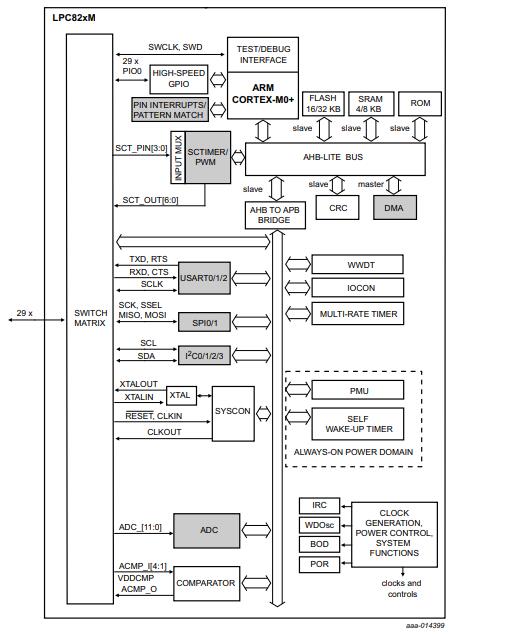
LPC824 Block Diagram
LPC824 Alternatives
LPC824M201JHI33Y
935304008551
935304008518
LPC824 Package

LPC824 Package
LPC824 Manufacturer
NXP Semiconductors provides mixed-signal and standard products based on its security, identification, automotive, networking, radio frequency, analogue signal, and power management expertise.
Datasheet PDF
- Datasheets :
- PCN Design/Specification :
- Environmental Information :
- PCN Assembly/Origin :
Popularity by Region
What is LPC824
The LPC824 is from LPC82x, an ARM Cortex-M0+ based, low-cost 32-bit MCU family operating at CPU frequencies of up to 30 MHz. The LPC82x support up to 32 KB of flash memory and 8 KB of SRAM. The peripheral complement of the LPC82x includes a CRC engine, four I2C-bus interfaces, up to three USARTs, up to two SPI interfaces, one multi-rate timer, self-wake-up timer, and a state-configurable timer with PWM function (SCTimer/PWM), a DMA, one 12-bit ADC and one analogue comparator, function-configurable I/O ports through a switch matrix, an input pattern match engine, and up to 29 general-purpose I/O pins.
What package is LPC824 available in?
It is available in an HVQFN33 (5x5) package.
What is the operating temperature range of LPC824?
Its operating temperature range is -40 °C to +105 °C.
What is the lpc824 Max LPCXpresso board with ARM Cortex-M0+?
The LPC824 MAX LPCXpresso board with NXP's ARM Cortex-M0+ microcontroller has been designed to make it as easy as possible to get started with Cortex-M0+ Where to buy? This product is no longer sold in our webshop, but it is available with NXP’s part number OM13071 from distributors.
What is the difference between the lpc81x and lpc82x MCUs?
The LPC82x MCU family provides higher integration over the LPC81x MCU family with a larger memory footprint, doubling maximum flash and SRAM size, an 18-ch DMA, the addition of more I2C serial interfaces and a 12-bit 1.2Msps ADC. this family provides three select peripherals to ease the transition into the 32-bit space.
How does the LPC800 pattern match engine work?
To simplify serial communication requirements, the pattern match engine can be configured to generate interrupts from user-configurable Boolean operations on its 8 pins. The LPC800 series shares critical pinouts through the range of subfamilies and packages and customers can easily swap or scale packages and subfamilies as their needs change.
What's new with LPCXpresso Max?
Embedded Artists and NXP are now proud to introduce the new generation of LPCXpresso MAX boards which build upon the original design, providing many new and exciting features.
 A Comprehensive Technical Guide to Microchip PIC16F1829TIML Microcontroller
A Comprehensive Technical Guide to Microchip PIC16F1829TIML Microcontroller29 February 2024132
 74HC595 Shift Register IC : Pinout, Advantage and Datasheet
74HC595 Shift Register IC : Pinout, Advantage and Datasheet13 September 20217387
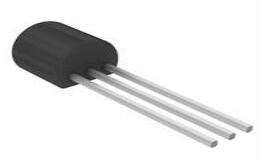 MPSA42 NPN Transistor: Pinout, Datasheet and Replacement
MPSA42 NPN Transistor: Pinout, Datasheet and Replacement12 October 202111492
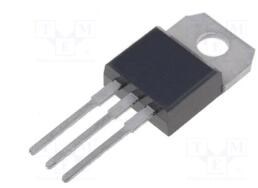 FAQs about TIP32C
FAQs about TIP32C26 April 20223297
![TDA7560 Amplifier: Circuits, Pinout, and Datasheet [Video&FAQ]](https://res.utmel.com/Images/Article/a48453ef-b366-48f0-ba0b-60b10ba25ed6.png) TDA7560 Amplifier: Circuits, Pinout, and Datasheet [Video&FAQ]
TDA7560 Amplifier: Circuits, Pinout, and Datasheet [Video&FAQ]12 January 202211711
 AD623 Instrumentation Amplifier: Pinout, Circuit and Alternatives
AD623 Instrumentation Amplifier: Pinout, Circuit and Alternatives04 August 20217814
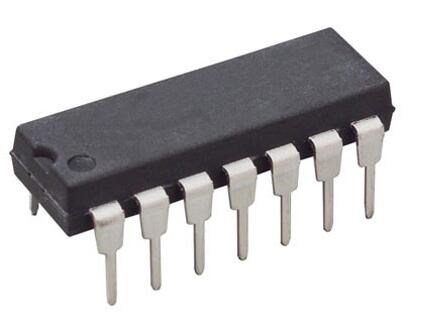 74LS107 Dual JK Flip-Flops: Flip-Flops Datasheet pdf, Pinout and Diagram
74LS107 Dual JK Flip-Flops: Flip-Flops Datasheet pdf, Pinout and Diagram20 December 20215771
 LIS2DE12TR Motion Sensor: Three-Axis Accelerometer, Datasheet, Application Hint
LIS2DE12TR Motion Sensor: Three-Axis Accelerometer, Datasheet, Application Hint26 February 20221638
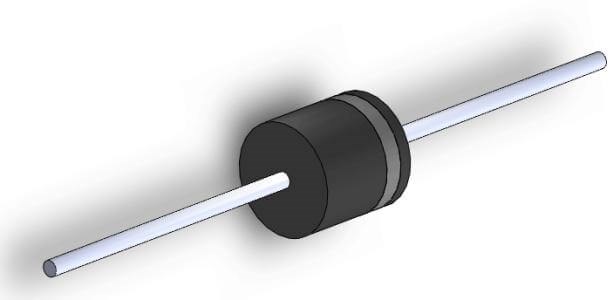 Introduction to TVS Diodes
Introduction to TVS Diodes07 August 202012695
 Introduction to Wireless Charger
Introduction to Wireless Charger27 July 20214147
 Switching Power Supply Debugging: 10 Most Common Problems
Switching Power Supply Debugging: 10 Most Common Problems21 February 202217978
 Methods for measuring the temperature of semiconductor devices
Methods for measuring the temperature of semiconductor devices14 November 20222038
 Introduction to Light-emitting Diode
Introduction to Light-emitting Diode23 October 20253758
 Semiconductor Industry's Uphill Battle Towards Net Zero
Semiconductor Industry's Uphill Battle Towards Net Zero22 September 2023620
 Introduction to buck, boost, and buck-boost converters
Introduction to buck, boost, and buck-boost converters28 September 202122131
 What is a Tactile Sensor?
What is a Tactile Sensor?21 October 20213460
NXP USA Inc.
In Stock: 20000
United States
China
Canada
Japan
Russia
Germany
United Kingdom
Singapore
Italy
Hong Kong(China)
Taiwan(China)
France
Korea
Mexico
Netherlands
Malaysia
Austria
Spain
Switzerland
Poland
Thailand
Vietnam
India
United Arab Emirates
Afghanistan
Åland Islands
Albania
Algeria
American Samoa
Andorra
Angola
Anguilla
Antigua & Barbuda
Argentina
Armenia
Aruba
Australia
Azerbaijan
Bahamas
Bahrain
Bangladesh
Barbados
Belarus
Belgium
Belize
Benin
Bermuda
Bhutan
Bolivia
Bonaire, Sint Eustatius and Saba
Bosnia & Herzegovina
Botswana
Brazil
British Indian Ocean Territory
British Virgin Islands
Brunei
Bulgaria
Burkina Faso
Burundi
Cabo Verde
Cambodia
Cameroon
Cayman Islands
Central African Republic
Chad
Chile
Christmas Island
Cocos (Keeling) Islands
Colombia
Comoros
Congo
Congo (DRC)
Cook Islands
Costa Rica
Côte d’Ivoire
Croatia
Cuba
Curaçao
Cyprus
Czechia
Denmark
Djibouti
Dominica
Dominican Republic
Ecuador
Egypt
El Salvador
Equatorial Guinea
Eritrea
Estonia
Eswatini
Ethiopia
Falkland Islands
Faroe Islands
Fiji
Finland
French Guiana
French Polynesia
Gabon
Gambia
Georgia
Ghana
Gibraltar
Greece
Greenland
Grenada
Guadeloupe
Guam
Guatemala
Guernsey
Guinea
Guinea-Bissau
Guyana
Haiti
Honduras
Hungary
Iceland
Indonesia
Iran
Iraq
Ireland
Isle of Man
Israel
Jamaica
Jersey
Jordan
Kazakhstan
Kenya
Kiribati
Kosovo
Kuwait
Kyrgyzstan
Laos
Latvia
Lebanon
Lesotho
Liberia
Libya
Liechtenstein
Lithuania
Luxembourg
Macao(China)
Madagascar
Malawi
Maldives
Mali
Malta
Marshall Islands
Martinique
Mauritania
Mauritius
Mayotte
Micronesia
Moldova
Monaco
Mongolia
Montenegro
Montserrat
Morocco
Mozambique
Myanmar
Namibia
Nauru
Nepal
New Caledonia
New Zealand
Nicaragua
Niger
Nigeria
Niue
Norfolk Island
North Korea
North Macedonia
Northern Mariana Islands
Norway
Oman
Pakistan
Palau
Palestinian Authority
Panama
Papua New Guinea
Paraguay
Peru
Philippines
Pitcairn Islands
Portugal
Puerto Rico
Qatar
Réunion
Romania
Rwanda
Samoa
San Marino
São Tomé & Príncipe
Saudi Arabia
Senegal
Serbia
Seychelles
Sierra Leone
Sint Maarten
Slovakia
Slovenia
Solomon Islands
Somalia
South Africa
South Sudan
Sri Lanka
St Helena, Ascension, Tristan da Cunha
St. Barthélemy
St. Kitts & Nevis
St. Lucia
St. Martin
St. Pierre & Miquelon
St. Vincent & Grenadines
Sudan
Suriname
Svalbard & Jan Mayen
Sweden
Syria
Tajikistan
Tanzania
Timor-Leste
Togo
Tokelau
Tonga
Trinidad & Tobago
Tunisia
Turkey
Turkmenistan
Turks & Caicos Islands
Tuvalu
U.S. Outlying Islands
U.S. Virgin Islands
Uganda
Ukraine
Uruguay
Uzbekistan
Vanuatu
Vatican City
Venezuela
Wallis & Futuna
Yemen
Zambia
Zimbabwe












